MDA, mda, or variation, may refer to:

3,4-Methylenedioxyamphetamine (MDA), is an empathogen-entactogen, psychostimulant, and psychedelic drug of the amphetamine family that is encountered mainly as a recreational drug. In terms of pharmacology, MDA acts most importantly as a serotonin-norepinephrine-dopamine releasing agent (SNDRA). Due to its euphoriant and hallucinogenic effects, the drug is a controlled substance and its possession and sale are illegal in most countries.

MMDA is a psychedelic and entactogen drug of the amphetamine class. It is an analogue of lophophine, MDA, and MDMA.

2-Bromo-4,5-methylenedioxyamphetamine (6-Bromo-MDA) is a lesser-known psychedelic drug and a substituted amphetamine. It was first synthesized by Alexander Shulgin. In his book PiHKAL, the dose is listed as 350 mg and the duration unknown. It produces stimulant effects but with no psychedelic or empathogenic action. Very little data exists about its pharmacological properties, metabolism, and toxicity.
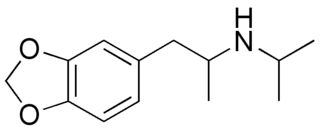
3,4-Methylenedioxy-N-isopropylamphetamine is a psychoactive drug of the phenethylamine and amphetamine chemical classes which acts as an entactogen, psychedelic, and stimulant. It is the N-isopropyl analogue of 3,4-methylenedioxyamphetamine (MDA). MDIP was first synthesized by Alexander Shulgin. In his book PiHKAL, the minimum dosage is listed as 250 mg. MDIP produces a mild threshold. Very little is known about the pharmacology, pharmacokinetics, effects, and toxicity of MDIP.
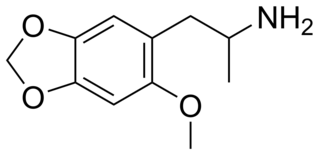
MMDA-2 (2-methoxy-4,5-methylenedioxyamphetamine) is a psychedelic drug of the amphetamine class. It is closely related to MMDA and MDA.

Methylenedioxyallylamphetamine is a lesser-known psychedelic drug. It is also the N-allyl derivative of 3,4-methylenedioxyamphetamine (MDA). MDAL was first synthesized by Alexander Shulgin. In his book PiHKAL, the minimum dosage is listed as 180 mg, and the duration unknown. MDAL produces few to no effects on its own, but may enhance the effects of LSD. Very little data exists about the pharmacological properties, metabolism, and toxicity of MDAL.
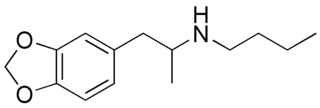
Methylenedioxybutylamphetamine is a lesser-known psychedelic drug. It is also the N-butyl derivative of 3,4-methylenedioxyamphetamine (MDA). MDBU was first synthesized by Alexander Shulgin. In his book PiHKAL, the minimum dosage is listed as 40 mg, and the duration unknown. MDBU produces few to no effects. Very little data exists about the pharmacological properties, metabolism, and toxicity of MDBU.

3,4-Methylenedioxy-N,N-dimethylamphetamine (MDDM) is a lesser-known psychedelic drug. It is also the N,N-dimethyl analog of 3,4-methylenedioxyamphetamine (MDA). MDDM was first synthesized by Alexander Shulgin. In his book PiHKAL , the dosage is unspecified and the duration unknown. MDDM produces only mild effects that are not well characterized in PiHKAL. Very little data exists about the pharmacological properties, metabolism, and toxicity of MDDM. This compound is however occasionally encountered as an impurity in 3,4-methylenedioxy-N-methylamphetamine (MDMA) which has been synthesized by methylation of MDA using methylating reagents such as methyl iodide. An excess of reagent or a reaction temperature that is too high results in some double methylation of the amine nitrogen, yielding MDDM as well as MDMA. The presence of MDDM as an impurity can thus reveal which synthetic route was used to manufacture seized samples of MDMA.
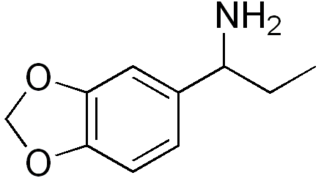
ALPHA (alpha-ethyl-3,4-methylenedioxybenzylamine) is a lesser-known psychedelic drug and a substituted benzylamine. It is also the benzylamine analog of 3,4-methylenedioxyamphetamine (MDA). ALPHA was first synthesized by Alexander Shulgin. In his book PIHKAL on the MDA page, the threshold dosage is listed as 10 mg. At mild threshold dosages there are eyes-closed "dreams" with some body tingling, at higher doses was reported to produce a pleasant, positive feeling. This compound is not anoretic at any dose. It lasts about 3 hours. Very little data exists about the pharmacological properties, metabolism, and toxicity of ALPHA.

5-Methyl-3,4-methylenedioxyamphetamine (5-Methyl-MDA) is an entactogen and psychedelic designer drug of the amphetamine class. It is a ring-methylated homologue of MDA and a structural isomer of MDMA.
A serotonin releasing agent (SRA) is a type of drug that induces the release of serotonin into the neuronal synaptic cleft. A selective serotonin releasing agent (SSRA) is an SRA with less significant or no efficacy in producing neurotransmitter efflux at other types of monoamine neurons.
The molecular formula C10H13NO2 (molar mass : 179.21 g/mol, exact mass : 179.094629) may refer to:

α-Methyldopamine (α-Me-DA), also known as 3,4-dihydroxyamphetamine, is a research chemical of the catecholamine and amphetamine chemical classes. Its bis-glutathionyl metabolite is slightly neurotoxic when directly injected into the brain's ventricles.

2,3-Methylenedioxyamphetamine (2,3-MDA) or ORTHO-MDA is an amphetamine derivative which is mentioned in PIHKAL as a fairly potent and long-lasting stimulant drug, but with little or none of the entactogenic effects associated with its better-known structural isomer MDA.

2-Methyl-3,4-methylenedioxyamphetamine (2-methyl-MDA) is an entactogen and psychedelic drug of the amphetamine class. It acts as a selective serotonin releasing agent (SSRA), with IC50 values of 93nM, 12,000nM, and 1,937nM for serotonin, dopamine, and norepinephrine efflux. 2-Methyl-MDA is more potent than MDA and 5-methyl-MDA. However, it is slightly more selective for serotonin over dopamine and norepinephrine release in comparison to 5-methyl-MDA.

6-Methyl-3,4-methylenedioxyamphetamine (6-Methyl-MDA) is an entactogen and psychedelic drug of the amphetamine class. It was first synthesized in the late 1990s by a team including David E. Nichols at Purdue University while investigating derivatives of 3,4-methylenedioxyamphetamine (MDA) and 3,4-methylenedioxy-N-methylamphetamine (MDMA).

Difluoromethylenedioxyamphetamine (DiFMDA) is a substituted derivative of 3,4-methylenedioxyamphetamine (MDA), which was developed by Daniel Trachsel and coworkers, along with the corresponding fluorinated derivatives of MDMA, MDEA, BDB and MBDB, with the aim of finding a non-neurotoxic drug able to be used as a less harmful substitute for entactogenic drugs such as MDMA. Since a major route of the normal metabolism of these compounds is scission of the methylenedioxy ring, producing neurotoxic metabolites such as alpha-methyldopamine, it was hoped that the difluoromethylenedioxy bioisostere would show increased metabolic stability and less toxicity.

3,4-Ethylidenedioxyamphetamine (EIDA) is a substituted derivative of 3,4-methylenedioxyamphetamine (MDA), which was developed by David Nichols and coworkers, in the course of research to determine the bulk tolerance around the benzodioxole portion of the MDA molecule. EIDA was found to produce similar effects to MDA in animals but with less than half the potency, while the isopropylidenedioxy derivative did not substitute for MDA and instead had sedative and convulsant effects. This shows limited bulk tolerance at this position and makes it likely the activity of EIDA will reside primarily in one enantiomer, although only the racemic mix has been studied as yet.
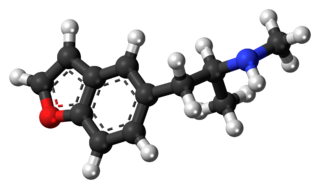
5-MAPB is an entactogenic designer drug similar to MDMA in its structure and effects.
















